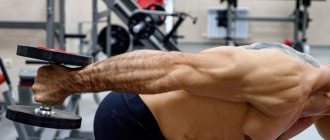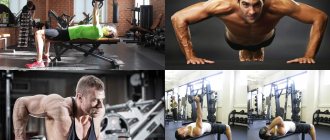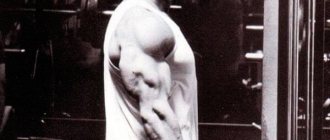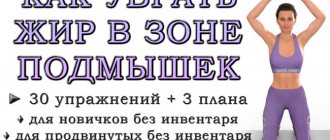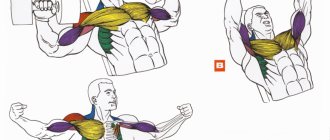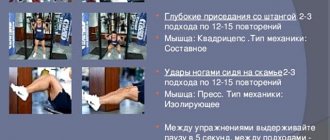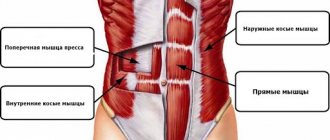© Yakov — stock.adobe.com
Share:
What you need
- barbell
- dumbbells
- simulators
- bars
The triceps brachii muscle is a massive muscle group that occupies approximately 2/3 of the arm's volume and has serious potential for hypertrophy and increased strength. In this article we will find out which triceps exercises are the most effective and how to properly train this muscle at home and in the gym.
Working muscles
Any triceps exercise one way or another involves all three of its bundles:
- Lateral.
- Long.
- Medial.
© bilderzwerg - stock.adobe.com
The more you stretch the triceps - for example, when lowering a barbell or dumbbell during a French press, the more intensely the long and medial fascicles work. If the emphasis of the exercise is on constant contraction of the triceps, as in the bench press with a close grip, arm extensions on the upper block or push-ups on the uneven bars, then the lateral bundle will work more strongly.
In all multi-joint basic movements, the load also falls on the anterior deltoids and pectoral muscles. The press also performs static work in almost all triceps exercises.
Standing overhead press of one dumbbell
The second most popular exercise with dumbbells is for triceps. Here we turn on the hands one by one. The biomechanics of the movement are very similar to those used in the seated overhead press.
Execution technique
- Take a dumbbell in your hand and bring it to the “over your head” position;
- While inhaling, we pulled it behind the head, and while exhaling, we fully straightened the lever in the elbow joint.
Perform alternately on each hand. Also, don’t forget that with this exercise we work all the same back extensors.
Recommendations for training triceps
A few basic recommendations for performing triceps exercises:
- Choose the right working weight and determine the range of repetitions. For massive triceps, combine both strength work (8-12 reps) and pumping (15-20 reps) in your training schedule. But remember that the exercise will not be effective if you do not feel the muscles working. You should feel your triceps contracting and stretching with each repetition.
- Gradually increase the weight of the additional weight when doing dips. This is one of the most traumatic exercises for the elbow joints. It is better to place this exercise closer to the final part of the workout and work with a relatively light weight.
- When performing French presses, it is fundamentally important to concentrate on stretching the triceps during the negative phase of the movement (during the descent). It should be 2 or even 3 times longer than the upward movement of the projectile. The whole benefit of this exercise lies precisely in this. In other movements you will not be able to stretch the medial head as much. Although the emphasis should be on the negative phase in all exercises for this muscle group.
- Minimize cheating (swinging of the body) when performing arm extensions on the upper block. Rocking deprives this exercise of any meaning and removes all the stress from the triceps brachii muscle.
- Use all available ways to increase the intensity of your training. The triceps are a relatively small muscle group: if you want to see noticeable progress, you need to hit it hard. Doing partial reps after reaching failure, asking a partner to help you do a couple extra reps, finishing off with light weights after each heavy set are all great for the triceps. But don't overdo it. This muscle also works actively during chest and deltoids training. Doing too many triceps exercises can ultimately lead to overtraining and lack of growth.
- Make the most of your rest time between sets by stretching your triceps. The more flexible your muscles are, the more comfortable you will be in performing exercises through a full range of motion. It will also improve pumping and neuromuscular communication, stretch the fascia and reduce the likelihood of injury.
- Experiment with your split program. Triceps can be trained together with the chest, back, shoulders or biceps. Choose the option that suits you best, or alternate variations monthly.
- Breaks between approaches should not exceed 1-1.5 minutes. This way, the flow of blood into the working muscles will be maximum, and the muscles will not have time to cool down after intense exercise. Perhaps the only exception is the heavy close-grip bench press, where more rest is allowed for recovery.
- If you train your arms on a separate day, work in supersets - work your triceps first, and then move on to your biceps. The triceps is a larger, stronger muscle that requires more heavy loads to grow. Therefore, it is advisable to first load it while you are full of energy. In addition, while you do the biceps, the triceps will rest, which can reduce your rest time.
Contraindications
Many athletes exclude any variations of the French press in order to protect their elbows. This makes sense if we have a strongman who already experiences increased stress on his elbows, but if we are talking about fitness, a couple of approaches with average weight will not critically affect the ligaments of the elbow joint if the athlete performs everything technically correctly.
A complete contraindication to the exercise is any inflammatory processes in the elbows, wrists and shoulders. First you need to heal them, and only then perform isolated exercises with flexion and extension in the joint.
The best exercises to work your triceps
The more intense your workouts, the more prerequisites for triceps growth you will create. Together with the blood, all the nutrients necessary for hypertrophy will enter the working muscle group.
However, this does not mean that arm training should last several hours, during which you will have time to do 10 or more exercises. To fully work out all 3 triceps bundles, 3-4 exercises are enough, which will take a maximum of 30-40 minutes. Let's look at the most effective exercises and their features.
Close grip bench press
This exercise is a basic exercise for the triceps muscles. Don't take its name too literally: the distance between your hands should be only slightly narrower than the width of your shoulders. This will ensure a full contraction of the triceps and will protect you from discomfort in the hands, shoulders and elbows.
Throughout the entire approach, it is important to keep your elbows as close to your body as possible, then the efficiency of this exercise will increase. If you have difficulty keeping the barbell level, do the Smith press with a close grip. This will make the exercise more isolated, as it will reduce the load on the stabilizer muscles.
French press
This is one of the best exercises for pumping up the triceps. It allows you to focus the load on the contraction of the long and medial fasciculus, and it is they who set the visual “massiveness” of the arm. To do this, lower the projectile as low as possible and take a short pause at the lowest point.
Remember that this version of the exercise is dangerous and requires good stretching, so you need to adequately assess your strength and not overdo it with working weights. Large weights (from about 50 kg) are also guaranteed to “kill” your elbows. Therefore, this exercise should be placed second or third in your program and done as technically as possible.
Most often, the French press is done lying with a barbell on a horizontal bench:
When performing the exercise lying down, it is best to lower the barbell behind your head, closer to the back of the head. In the starting position, the arms should not be perpendicular to the body, but tilted at a slight angle towards the head. Thus, even in this position (and throughout the entire approach), the triceps will be tense and we will be able to slightly reduce the weight of the projectile for safety.
Using dumbbells can slightly reduce the stress on the ligaments and tendons of the elbow joint, although the movement becomes a little more difficult. However, with a narrower grip, you can lower the dumbbells even lower and stretch your triceps more:
© Makatserchyk — stock.adobe.com
A good option for variety is to perform a French press while sitting on a bench or standing. You must remember not to spread your elbows too far to the sides, but try to keep them at the same level throughout the entire set:
© Makatserchyk — stock.adobe.com
This group also includes extensions with one dumbbell with both hands from behind the head. The exercise is similar to the seated French press, but throwing and holding a large dumbbell will be harder.
© Nicholas Piccillo - stock.adobe.com
A variation of the last movement is a one-arm overhead extension with a dumbbell. Girls do this exercise more often:
© bertys30 — stock.adobe.com
Dips
This is a multi-joint exercise in which the load is distributed between the pectoral muscles and triceps. To target the triceps brachii muscle specifically, keep your body straight throughout the entire approach. No forward bending or rounding of the thoracic spine. Keep your elbows close to your body and do not spread them out to the sides, otherwise the entire load will shift to the lower pectoral muscles. In this case, it will be good if the distance between the bars is only slightly wider than the shoulders.
There is no need to go as deep as possible; this will only lead to discomfort in the shoulder joints and ligaments. Lower yourself down until you form a right angle between your forearm and upper arm. When you can easily work out 3-4 sets with your own weight, performing at least 15 repetitions, use additional weights.
Extension on the block
This is an isolated exercise for local development of the lateral head of the triceps. Although this is the smallest part of the muscle, you need to devote no less time to it than the rest, since it is this that sets the “horseshoe” shape of the triceps. This exercise usually ends your arm training.
To ensure maximum blood flow to the triceps brachii muscle, work with light weights without supporting yourself with your core. Don't forget to focus on the negative phase of the movement. At the moment of full extension of the elbow joint, tighten your triceps as much as possible for 1-2 seconds. The number of repetitions is at least 12. Press your elbows to your ribs throughout the entire approach.
To “hook” as many muscle fibers as possible, use all the handles available in your gym and vary your grip from wide to narrow (from workout to workout, not the same). This triceps exercise can also be done in a crossover.
The most common option is extension with a rope:
© Jale Ibrak — stock.adobe.com
Also popular is a straight handle, which allows you to take a little more weight:
© blackday — stock.adobe.com
Another interesting option is the extension of one arm with a reverse grip:
© zamuruev — stock.adobe.com
Push ups
The triceps come into play perfectly when doing push-ups with a narrow hand position. This is an ideal exercise for home workouts. To further target the lateral triceps, point your hands with your fingers facing each other. The elbows will be directed in different directions, but in this particular case it will only increase the peak contraction. It is also worth doing plyometric push-ups (with clapping) from time to time, they are great for developing the explosive power of your triceps.
This also includes reverse push-ups from a bench or any other elevation:
© undrey — stock.adobe.com
Neutral grip dumbbell press
This exercise is similar to a regular dumbbell bench press. The difference is that the grip here is neutral, that is, the palms are facing each other, and not towards the legs. When lowering the dumbbells, try to keep your elbows as close to your body as possible, rather than out to the sides. In this case, there is no need for the projectiles to touch; keep them at a short distance from each other.
© Makatserchyk — stock.adobe.com
Kickbacks
This exercise involves moving the arm back with a dumbbell while the athlete himself is bent over. Kickback can be performed with one dumbbell alternately or with two at once.
© Makatserchyk — stock.adobe.com
The slope should ideally be such that the body is almost parallel to the floor.
You can lean on the bench or even lie on your stomach. Alternatively, you can do a kickback on the lower block:
Dumbbell press from behind the head with two hands
An excellent near-basic (multi-joint) exercise that allows you to load both arms at once.
- Take the dumbbell in your hands, then carefully place it on your shoulder;
- Move it from your shoulder to the “over your head” position - this is the starting position in the exercise;
- Now, while inhaling, lower the dumbbell behind your head to an angle of ninety degrees, slightly spreading your elbows (this is important - do not move your elbows far to the sides in order to “hit” the triceps as accurately as possible);
- Then, as you exhale, press the dumbbell above you, fully “inserting” (straightening at the elbow) the levers (that is, your arms);
- At the same time, keep your body as vertical as possible, without leaning forward or backward.
In this position we also train our main muscles - the stabilizer-extensors (large pillars at the lower back) of the back. Also a huge plus.
Progression of loads
We figured out what exercises pump the triceps. However, no set of exercises will give the desired result if you do not improve your performance at each workout.
There are several ways to do this:
- Increasing working weights. The method is fundamentally important for basic exercises, but for isolation it is advisable to gradually increase the weight used - of course, without compromising technique. This is done like this: you did 3 sets of bench press with a narrow grip with a weight of 80 kg for 10 repetitions. For your next workout, try lifting a weight of 82.5 kg. Most likely, you won’t be able to do 10 reps in all sets, but it will come out to about 10-8-6. Continue with this weight until you can do 10-10-10. After this, increase the working weight by another 2.5 kg.
- Increasing the number of repetitions. Let's say you were able to do 3 sets of strict barbell French presses for 12 reps. Weight does not play a role in this case. In your next workout, try to do 13 repetitions without compromising your technique or increasing the rest time between sets. Next time - 14, then - 15. After that, slightly increase the weight of the barbell, drop again to 12 repetitions and repeat all over again.
- Increasing the number of approaches. When you can easily complete 3 sets of any triceps exercise, do another set. The number of repetitions and rest time remain the same. Increasing your training volume (within reasonable limits) is a powerful stimulus for growth.
- Adding new exercises . This technique is only suitable for experienced athletes. If you feel that three or four exercises are no longer enough to properly pump up your triceps, add one more exercise to your program. Start with light isolation, and if this is not enough, complete the arm workout with a French bench press with a barbell or dips with additional weight. Painful sensations are guaranteed the next day.
- Reducing rest time between sets. It will be difficult at first, but with experience your muscles will become more resilient: you will not lose productivity using minimal rest time. The blood supply to the muscles will be much stronger.
- Increasing the number of workouts. This option will help athletes whose arm muscles stubbornly refuse to grow. There are many reasons for stagnation, but in most cases, more frequent and intense training successfully solves the problem. Train your triceps twice a week: the first time with your chest, the second time with your biceps. You can do lighter workouts in supersets to achieve maximum pump. This should help you build up your arms.
Recipes for healthy eating
Beef rolls with bacon in the oven
- 13.9 g Protein
- 9.9 g Fat
- 3.6 g Carbohydrates
- 163.5 kcal
60-80 min.
- #wine
- #second course
- #beef
- #baking
- #greenery
- #dinner
- #olive oil
- #onion
- #spices
- #dinner
- #garlic
Other recipes
